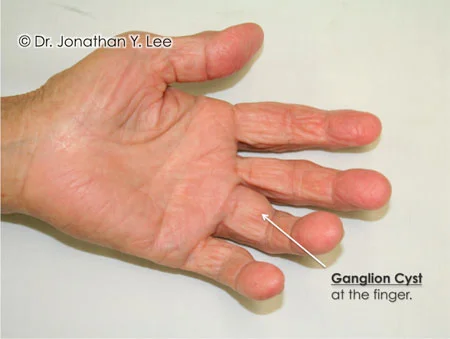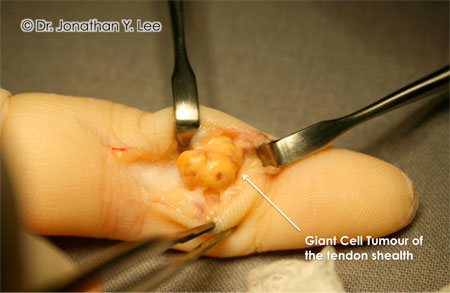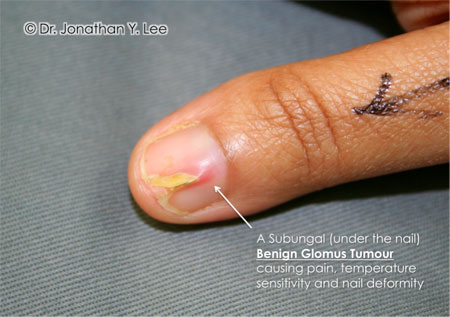WHAT ARE HAND TUMOURS?
Any abnormal lump or bump is considered a tumour. A tumour can also be referred to as a “mass”. The term “tumour” does not necessarily mean it is malignant or it is a cancer. The majority of hand tumours are in fact benign or non-cancerous. Any lump or bump in your hand is a tumour regardless of what causes it. Hand tumours can occur on the skin, like a mole or a wart, or can occur underneath the skin in the soft tissue or even the bone. Because there are so many tissue types in the hand (e.g. skin, tendon, fat, ligaments, bone, etc), there are many types of tumours that can occur. However, only a few of them are seen commonly.
WHAT TYPES OF HAND TUMOURS ARE THERE?
Ganglion Cyst
The most common tumour in the hand and wrist is a Ganglion Cyst (Figure 1 and 2). These are benign sacs of gelatinous fluid that form off of a joint or tendon sheath. They are seen frequently in the wrist but can also occur around finger joints. They form when a portion of the joint capsule or tendon sheath starts ballooning out and becomes filled with the fluid that lubricates the joint or tendon. The diagnosis and treatment options for ganglion cysts are discussed in further detail on a specific webpage page elsewhere on our website.
Figure 1: A common location to have a ganglion cyst is on the back of the wrist.
Figure 2: The 2nd most common hand tumour is a Giant Cell Tumour of Tendon Sheath. Unlike the fluid-filled ganglion cyst, these tumours are solid masses. They can occur anywhere there is a nearby tendon sheath. They are benign, slow-growing masses that spread through the soft tissue underneath the skin (Figure 3 and Figure 4). Some believe that they may be caused by trauma that stimulates the tendon sheath to start growing abnormally. They are not cancerous.
Figure 3: A Giant Cell Tendon Sheath Tumour of the Thumb.
Figure 4: Giant Cell Tendon Sheath Tumour of the finger.
Epidermal Inclusion Cyst
Figure 5: Epidermal inclusion cyst of the finger
Another common tumour is an Epidermal Inclusion Cyst (see Figure 5). It is also benign and forms just underneath the skin, originating from the undersurface of the skin where there may have been a cut or puncture. Skin cells normally secrete a protective waxy substance called keratin. They also undergo a cycle in which surface skin cells die and slough off into the environment. When skin cells get trapped under the surface, they continue to make keratin and continue to reproduce and slough. The keratin and dead skin cells get trapped underneath the skin and start forming the cyst. The cyst increases in size as more keratin is produced and more skin cells die. Ultimately, you get a fibrous sac filled with a cheesy substance that is attached to the undersurface of the skin from where it arose.
Other type of Tumour
Figure 6: Glomus Tumour underneath the fingernail.
There are other less common types of tumours seen in the hand. They include Lipomas (fatty tumours), Neuromas, Nerve Sheath Tumours, Fibromas, Pyogenic Granulomas and Glomus Tumours among others (see Figure 3). They are practically all benign. Bone spurs can form, from arthritis or trauma, which feel like hard tumours. Foreign bodies, like a splinter, can also cause reactions that form lumps or bumps in the hand.
Figure 7: Fibroma of the little finger
Figure 8: A pyogenic granuloma in the palm























